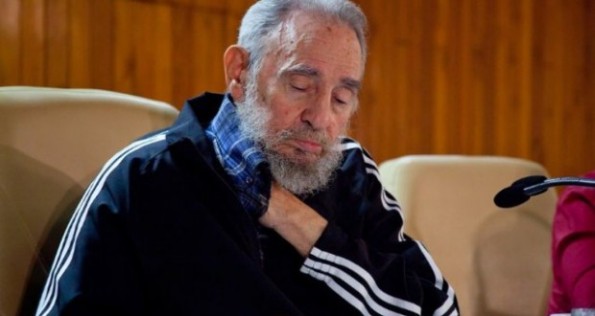 Never has the life or death of one man awakened such dissimilar expectations. Fidel Castro, who turns 87 on August 13, has been given up for dead so many times that when death does come for him, many will believe it’s a joke.
Never has the life or death of one man awakened such dissimilar expectations. Fidel Castro, who turns 87 on August 13, has been given up for dead so many times that when death does come for him, many will believe it’s a joke.
Castro, aware of the countless times he has cheated death, has woven a legend around himself. After the 1953 assault on a military barracks in Santiago de Cuba, several newspapers of the time published the news of his demise.
The military escapade of trying to take a military fortress with a troop of inexperienced amateur soldiers armed with dove-hunting rifles ended, of course, in a complete rout.
Most of the young assailants were killed in battle or executed by the repressive forces of the Fulgencio Batista regime. In those days, the life of Fidel Castro wasn’t worth much.
But the 26-year-old lawyer, born 500 miles east of Havana on a farm in the Birán region of Holguin, managed to avoid being executed by a bullet to the head thanks to Lieutenant Sarria, a Republican Army officer who saved his life.
Then in prison, according to the official history, they tried to poison him.
When on December 2, 1956 he landed with an army of 82 men on the beach at Las Coloradas, a rugged area infested by swamps, Batista’s Air Force, which was aware of the landing site in advance, made target practice of the bewildered guerrillas.
Everyone gave Fidel Castro up for dead. They were so sure of his death that the troops shut down their actions against the guerrilla. Once again the “subversive one” had escaped death.
You already know the story. He regrouped with the survivors of his band, and with the help of peasant farmers, the inefficiency of the army, and collections of money and weapons from political parties opposed to Batista, he managed to seize power in January 1959.
Two years earlier, in the Sierra Maestra, he escaped by a complete miracle. His right-hand man, who slept 15 feet from his hammock, was an Army plant. But the guy lacked the guts to kill him, as had been planned. The “traitor” was caught by the guerrillas and executed.
Once in power, he was left unscathed by various attempts conceived by former comrades-in-arms, a German lover, the CIA, and anti-Castro exiles. He exaggerates this. He says the U.S. special services tried to kill him more than 600 times.
Castro and the official media aggrandize everything, from production statistics to attacks on his life. What is documented is that at least twelve times the CIA and opposition groups planned to kill him.
On a visit to Chile in 1973, an anti-Castro commando was about to execute him. A gun fastened to a television camera was pointed at his head. But without a safe path of escape, the organizers decided to abort the attempt.
On Monday, July 31, 2006, when Carlos Valenciaga, his personal secretary, announced that due to serious health problems Fidel had delegated power to his brother Raul, the government began to prepare his funeral ceremony, and on a massive mountain in the Sierra Maestra they urgently built a monumental tomb.
From that date, the international press has had his obituaries at the ready. A foreign reporter told me that his agency had sent him to Havana for the sole purpose of reporting the day of death of the leader of the revolution.
Until then, he was asked to maintain a low profile while waiting for the big news. He has now lost count of the number of times Castro has been “killed” in Florida.
Seven years after Fidel Castro’s retirement for health reasons, Cubans barely speak of the former president. No one on the street takes seriously what he says or writes. He’s like a grandfather with dementia who in his lucid moments likes to tell tales of his epic exploits.
After arriving in “death’s waiting room,” as he confided to a journalist from the Mexican newspaper La Jornada, he has dedicated himself to: prophesying the end of the world after a nuclear war; alerting the world to an alleged conspiracy by the Bilderberg Club; and investigating the moringa, a plant that, in his opinion, “could save the starving Third World.”
To this day, on television roundtables and news reports, any crazy pronouncement by the Commander-in-Chief is read in a serious tone. Today, more than ever, you can see in the state media his cult of personality.
In celebration of his birthday, songfests, sports marathons, and book releases are anticipated. But due to the daily grind of hardship without letup, a broad segment of the public does not have pleasant feelings toward its former top leader.
They blame him for the delays, the shortages, and the precarious standard of living in the country today. They see him as a distant ship sailing toward the horizon. Few ask anymore what it will be like the day after his death.
And the direction taken by the General suggests that the legacy of his brother will endure after his physical disappearance. Predictions about the future of Cuba are bleak.
For many on the island, at a time when the developed world remains embroiled in a financial and political crisis with no end in sight, the desired democratic change seems unlikely.
All they can see in the picture is more Castroism. Without Fidel Castro.
Iván García
Photo: Fidel Castro during the presentation of the book Warrior of Time, by Cuban journalist Katiuska Blanco, in February 2012. Taken from El Nuevo Diario de Nicaragua.
Translated by Tomás A.
13 August 2013
